A project by Katy Ewing, Writer in Residence at Oxfam Books and Music Dumfries.
Don't wanna be here? Send us removal request.
Text
From Above
How can you see all the angles of a town? Of course you can’t, at least not at the same time – but you can keep trying, keep gathering, keep learning.* I’m trying to build up a multidimensional picture layer by layer - a map of Dumfries that isn't flat, but is rather like a portrait that grows from many angles. I've been trying to find the best 'way in' to this portrait, sketching a rough outline before properly beginning to flesh out the details.
I wanted some kind of overview, starting with a way to photograph for myself something like the aerial view of Dumfries that I’d seen on Google and Bing maps. From memory, I’d at first thought that the steep downhill on the way in from Castle Douglas (the Glen), might have somewhere with a good view from above where I could park and photograph - but no, on the A75 the obligatory planted mixed native deciduous roadside trees are now old enough to be a beautiful screen of green in this season.
Then I remembered the Camera Obscura. I’ve only ever been a few times, most recently I think 17 years ago when my youngest daughter was a baby who didn’t like the heat of summer or the confusion of bustling strangers, so my mum helped my 4 year old to see while I sat out of the way, baby-calming. And before that, when I was a child myself (and probably too shy to get close enough to see properly!). So this visit was really an enormous treat – I’d told the museum staff in advance that I was coming and why, and by luck I was the only visitor, so the views were all mine…
I’m led upstairs by Susan the Gallery Attendant, past exhibits on the first floor, then up the spiral staircase, our footsteps sounding on wooden steps winding around a wooden post (which had originally been a ship’s mast and which may have been part of the building when it was a windmill, and which has to slant slightly from upright in order for the steps of the spiral staircase to maintain the same tread all the way up…)
There are so many fantastic stories attached just to this building - this link contains many of them (I almost want to do a whole poetry pamphlet on just this tower). An excerpt:
‘In the autumn of 1834 there were proposals afoot to demolish the old windmill which stood at the top of Corbelly Hill and redevelop the site. This met considerable opposition and Robert Thomson, shipowner, shipbuilder merchant and pioneer of trade with New Brunswick and Prince Edward Island, circulated a printed subscription form round the town -
"The spirit of commercial enterprise respects not objects, however picturesque and as the fate of the building has thus been decreed, nothing can save it but union and exertion on the part of those to whom it is nearly as dear as the Nith itself. In every part of the world there are Dumfriesians who remember well the Corbelly Hill with the mill, the kiln and the cozie seat which this latter afforded them in a winter day, the huge reefed arms that expanded above and the long and broad shadows they incessantly cast when the wind was strong and the weather fine, It is proposed therefore to form an Association under the name of the Dumfries and Maxwelltown Astronomical Society".
One of their principal aims was "That a Telescope and a Camera Obscura be purchased as soon as the necessary funds can be raised"’.
There is much more to this story, but I feel very glad that the plan succeeded and the camera obscura which opened to the public on 1st August 1836 is still intact and working wonderfully.
We pause on the second floor and Susan takes me to the windows to show me landmarks which will help me orientate – I laugh nervously, that yes, I’m not that great at knowing where things are in relation to each other. There’s also just been the upward journey by windowless spiral staircase which could be a tiny bit like being blindfolded and spun round in ‘Blind Man’s Buff’...
She points out the flag outside on a flagpole, and yes, there’s the pointy top of the Cuckoo Bridge towards the A76 (about a mile NNW), there’s the Midsteeple (much closer, NNE), the Church Street chimneys (just along the road), Palmerston stadium. She shows me the information boards on this floor that tell the story of the building, the bust of Robert Thomson, the man who bought and saved the building in 1834, and the life-size figure of Walter Newall, the architect who designed the conversion of the windmill tower into an observatory and supervised the work.
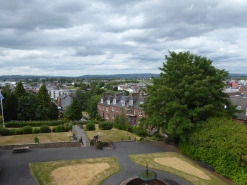

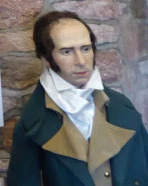
We carry on up the spiral stairway to the very top, where we're faced by a curved door (apparently a speciality of the architect), which Susan unlocks before showing me in. The room is smaller than I remember (of course), darkened and cosy, though a fan is cooling it in this unusual current hot spell. There is a guard rail around the table-like white dish where the image will be projected and ropes which operate the lens and mirror above hang down from a circular gap in the ceiling. One rope opens the lid which protects the apparatus from the weather, another adjusts the mirror which reflects an image down through a lens and a third rotates the turret through 360 degrees so that the views can be seen in any direction. The image is brought into focus by raising or lowering the projection table which has a counterweight below for this purpose, between the two floors. Susan lets me adjust this myself to feel the working of the mechanism, which is very satisfying - another beautifully conceived and built device.
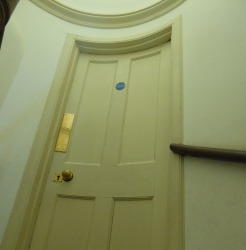
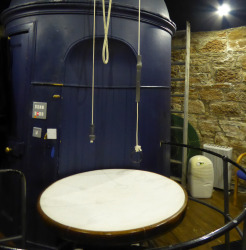
The light is switched off, the mirror tilted and the image brought into focus. We start close in at the museum's front gate, Susan again pointing out the landmarks we'd seen from the window below and some new ones - the flag outside, the Crichton Church spire, the hazy view across the Solway to the Lake District... We progress around the town all the way around, from close views to distant.
The perspective is very fresh from here, the familiar made unfamiliar, and as I remember from childhood, maybe the oddest thing is to see movement; cars and buses on roads, people walking. Although of course I knew it was a live image, this still feels unreal and the dark room, the circular image with us leaning over it does have a slightly witchcrafty feel, the vivid scene both a trick of the light and a true feed from the outside world. I'd love to be able to see the first images projected in 1836 and the faces of the viewers (initially elite viewers, eventually in 1849, the paying public, but only on Saturdays).
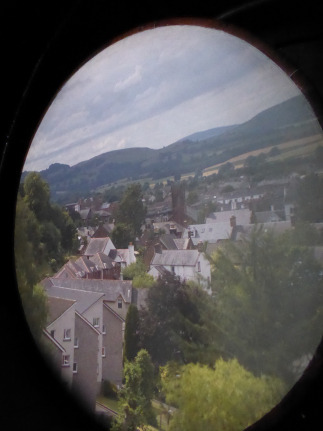
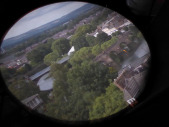
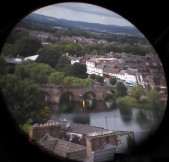
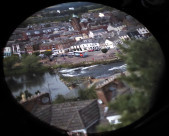
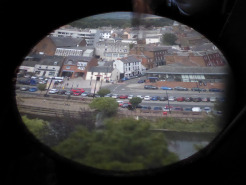
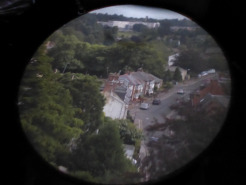
Again from this link, when the observatory first opened:
'The newspaper reported that "when the Telescope was pointed to the lower part of the town, a lady was seen sitting at her window reading a letter, and when this was mentioned, Mr Morton remarked that by putting in the most powerful glass, he could enable the beholder to read the letter too. This, however, was not done, and if the Directors can help it, it will never be attempted. When the strongest glass was tried placards were read on the walls of Mr Rankine's and other shops near the Old Bridge". As for the Camera Obscura - "the colouring is as perfect as the eye could desire, and as the weather on Saturday was breezy in the extreme, it was beautiful to observe huge masses of river water chafed into foam as it hurried along. But it would be endless to record all the pleasure the Camera table affords, let our town readers therefore cross the bridge and judge for themselves, under the firm conviction that even the walk will do them good".'
I've certainly gained some new perspective here, both into Dumfries now and in the past - for example, when the Observatory opened, this area overlooked Dumfries but was not yet part of the town. I'm surprised too by how green the town looks from above, how many trees there are - one idea I'd had was to have a Dumfries version of the Edinburgh Tree Map, but I now realise this would be a much bigger task than I thought!
Back downstairs, I wish I had more time to view the museum's wonderful exhibits [I'd highly recommend visiting the museum and camera obscura for yourself, both are really amazing and the staff are friendly and informative - more information here and here].
I return to the slabs of sandstone on the ground floor which have Permian period fossil footprints, discovered locally during the same flourish of scientific interest and activity in which the observatory came about. If I want to really know who Dumfries is, maybe I need to return first to what it is made of - the stone, the water, the weather...
*A really excellent resource for me to quickly and enjoyably fill in much detail in many aspects of Dumfries’s history has been the newly published Secret Dumfries by Mary Smith and Keith Kirk, published by Amberley - well worth checking out!
Deep Mapping Dumfries on Wordpress here.
#dumfries#deep mapping#deep mapping dumfries#dumfries museum#camera obscura#dumfries and galloway#psychogeography#scotland#photography#writing#writers#placemaking#poetry#prose
0 notes
Text
Introduction to Deep Mapping Dumfries
"... the deep map attempts to record and represent the grain and patina of place through juxtapositions and interpenetrations of the historical and the contemporary, the political and the poetic, the discursive and the sensual; the conflation of oral testimony, anthology, memoir, biography, natural history and everything you might ever want to say about a place …"
Mike Pearson and Michael Shanks, Theatre/Archaeology (Routledge 2001) p. 64-65
The Deep Map
Maps can be useful, interesting, often beautiful. But any map can only ever portray a particular aspect of a place – and because they are always partial, maps are inherently biased and therefore political.
This is an experiment. An attempt to make a ‘deep map’ of Dumfries - an interdisciplinary, multi-layered, multimedia portrait of the town, from a ‘centre’ that is Oxfam Books and Music Dumfries, where I’m based as writer in residence. The eventual product will depend on how much and what kind of response I get from others. I will work on the deep map using as many other perspectives as I can and the more other voices I’m able to include, the richer the map could be – so how the map ends up shaped depends partly on you!
Are you someone who has known Dumfries your whole life? Or someone who moved here recently? Do you, like me, live outside Dumfries, but know it as the main town? Maybe you’ve only ever visited but have some particular important memory associated with it. Or do you have some expert knowledge – perhaps historical, archaeological, botanical, zoological, even mythological? Each will have quite a different perspective of the same particular places. If we could gather many of these, what could we build?
Throughout the project, I’ll be providing prompts – perhaps photos of particular places, or interesting facts about them or poems on particular themes, hoping to get people’s memories and connections to particular places reawakened. I’ll also be running some place writing workshops to help get folks’ writerly juices flowing! And I’ll be attempting a ‘Poetry Map of Dumfries’, similar to the Stanza ‘Poetry Map of Scotland.’
The project is somewhat fluid, and will be further shaped as it carries on – look out for further developments on how to get involved, here and on the Oxfam Dumfries Facebook page.
Why Dumfries?
I studied in Dumfries as a mature student, at the University of Glasgow’s School of Interdisciplinary Studies. I graduated in 2017 with an MLitt in Environment, Culture and Communication. On this taught degree, amongst other things, I learned much about how previous writers have written about place, about being in particular place and what that means for being a human and trying to live well. I also began developing a creative practice which attempts to incorporate my skills as a writer, artist and researcher, to portray particular place in a profoundly layered and multiple way - just as our experience of the world is always profoundly layered and multiple.
At the same time, I had begun to work on my own issues with anxiety and poor self-confidence by learning and practicing mindfulness meditation. This mainly consists of learning to notice – to notice what your mind is thinking and what your body is feeling, learning how to try to be really present in the world, rather than always absorbed in thoughts about the past or worries about the future, fears about how others see you. These things never fully go away, but almost like magic, the practice of noticing them (or trying to notice them as often as possible) without judgement takes away massive amounts of how damaging they are and helps you make a start at feeling at home in yourself. I didn’t believe it could happen until it did.
This practice of noticing, or remembering to keep trying to notice, also helped me to see how much our experience of the world is always filtered by what we know, or think we know. Our experience of place can be hugely affected by what we know about it and by what emotions and memories we connect with it.
My family moved to Dumfries and Galloway when I was 4. When I was a wee girl, Dumfries was the big town we’d get the bus to once a week, where my mum would get her fruit and veg at the market, where the swimming pool was and all the shops and shoppers in the High Street, the vennel – and where the fair would land twice a year, the wonderful, terrifying, sickening, money-draining fair. As a teenager Dumfries was a Saturday hang out, later a pub venue (though the lack of night buses meant this was a rare affair). It was where I went to college, later university, where I had both babies, where hospital visits good and bad take place. Now, it’s where I volunteer at Oxfam Books and Music, trying to be of some use to the world, finding I maybe can be. So even just to me, Dumfries is not a single place; it’s all of this and much more. Add in the memories and experiences of all the others connected to Dumfries and what a rich and complex picture you’d have.
But Dumfries is also all the things that ever happened to make it what it is now – how the rocks were formed that it’s built on and of, how the soil was formed, how the river flows and why, how the climate is and has been. What plants grow here, and what other creatures we share it with. Which powerful and legendary people made which things happen. And all of this is interconnected.
In recent years, all the towns I know have changed; shops have closed and charity shops, e-cig outlets and bookies are dotted about between boarded up premises. Many of us still want to visit towns but it feels as though we don’t quite know what they’re for any more. Dumfries is in the midst of finding out who it wants to be, what it can be. Many incredibly positive, innovative and community-based placemaking projects are ongoing – including, but not limited to: The Stove Network, the Midsteeple Quarter), Incredible Edible, MOOL (Massive Outpouring of Love) and of course Oxfam Books and Music Dumfries’s various projects, including the current ‘Art Beats Poverty’ summer programme. In order to add to this, I’m going to do what I can to try to build up a portrait of who Dumfries is and has been. I hope that this can be ongoing and include the voices and perspectives of as many folk as possible.
Cliff McLucas - "There are ten things that I can say about these deep maps.
First. Deep maps will be big – the issue of resolution and detail is addressed by size.
Second. Deep maps will be slow – they will naturally move at a speed of landform or weather.
Third. Deep maps will be sumptuous – they will embrace a range of different media or registers in a sophisticated and multilayered orchestration.
Fourth. Deep maps will only be achieved by the articulation of a variety of media – they will be genuinely multimedia, not as an aesthetic gesture or affectation, but as a practical necessity.
Fifth. Deep maps will have at least three basic elements – a graphic work (large, horizontal or vertical), a time-based media component (film, video, performance), and a database or archival system that remains open and unfinished.
Sixth. Deep maps will require the engagement of both the insider and outsider.
Seventh. Deep maps will bring together the amateur and the professional, the artist and the scientist, the official and the unofficial, the national and the local.
Eighth. Deep maps might only be possible and perhaps imaginable now – the digital processes at the heart of most modern media practices are allowing, for the first time, the easy combination of different orders of material – a new creative space.
Ninth. Deep maps will not seek the authority and objectivity of conventional cartography. They will be politicized, passionate, and partisan. They will involve negotiation and contestation over who and what is represented and how. They will give rise to debate about the documentation and portrayal of people and places.
Tenth. Deep maps will be unstable, fragile and temporary. They will be a conversation and not a statement."
http://cliffordmclucas.info/deep-mapping.html
Deep Mapping Dumfries on Wordpress here.
#dumfries#writing#scotland#psychogeography#deep mapping#placemaking#poetry#prose#photography#art#community
3 notes
·
View notes